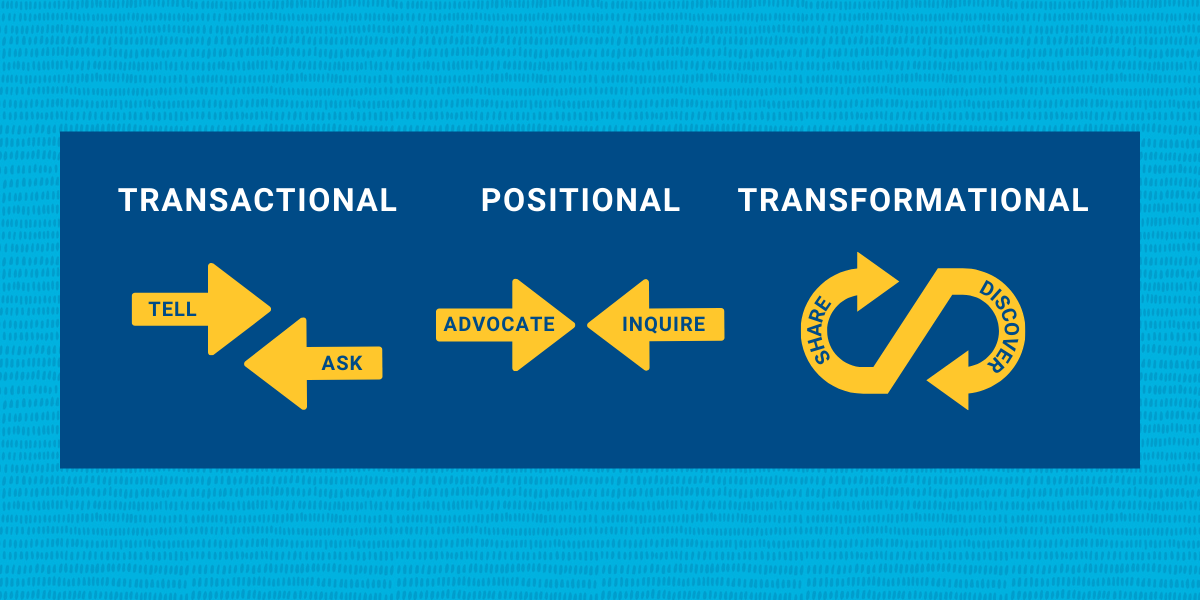
Virtual work isn’t going anywhere. It’s here to stay, and it’s time we start to evaluate how we can make our virtual relationships with our colleagues and clients the best they can be.
Our success, personally and professionally, is so heavily impacted by the quality of our relationships. That means our relationships with our peers, leaders, those we may lead, clients, customers, and anyone we interface to achieve our work. And the quality of our conversations with these partners is often the keystone in determining the strength of our relationships.
What makes relationships challenging, is that we’re programmed to protect ourselves while also being wired for connection with others. Not only can fear and conflict alter the chemistry of the brain, but they also alter how we feel, behave, and are perceived by others. It just takes a moment for us to go from a trusted friend and mentor to someone of which to be leery.
We’ve talked at length about the immediate steps to take when a regrettable event occurs in the workplace and how to apologize quickly and effectively. But what we haven’t addressed in much detail is how to repair those relationships following the apology.
And remember – it isn’t if a regrettable event will occur; it’s when.
What Regrettable Events Can Look Like Virtually
A regrettable event can mean that someone delivered a message with good intentions but negatively impacted the outcome.
It can look like two parties not showing in a situation as their best selves. When our brains are stressed because of fatigue or hunger, or we’re in a position where the entire world has experienced 18 months of trauma, we can often default to a reactive response instead of an intentional one.
And indeed, regrettable events can be caused by malicious intent.
One of the things we’ve observed in our work is that working virtually appears to have minimized some of the classic Elephant*-feeding behaviors. But what I’ve found is that they look and feel a little different now.
*Elephant: looks like avoidance of addressing a known conflict that creates a harmful barrier to success. It’s big. It’s there. It might be hanging out in the conference room under someone’s chair or even sprawled across the table. Everyone is aware of this elephant in the room, and no one’s talking about it.
A virtual Elephant can look like:
- People on the video conference become quiet.
- In the background of the call, you suddenly hear pings and alerts for instant messaging conversations.
- Someone poses a question, but nobody answers (or people respond with sarcasm or passive aggression)
- People change the subject.
- People’s body language is closed off (i.e., crossed arms).
Regardless of how we arrive at a regrettable event, please understand that it will occur. According to SHRM, 81% of remote workers have experienced workplace conflict, and 46% have used a messaging application for their arguments.
Even more troubling, after enduring virtual conflict with a co-worker or a boss, 39% of respondents to the SHRM study said they wanted to leave or left their jobs due to the problem.
Our goal in building high-trust effective relationships is not to avoid or never have regrettable events but to identify them and recover from them more quickly.
And the best way to recover? Through conversation.
Three Types of Virtual Conversations
The work of Judith E. Glaser, the founder, and researcher behind Conversational Intelligence®, explores neuroscience or trust. I was fortunate to be one of the few in Iowa to train and certify in Conversational Intelligence. And through my certification work, I was made aware of three conversation patterns.
 There are many dimensions to a conversation, not just one:
There are many dimensions to a conversation, not just one:
- What we think,
- What we say,
- How we say it,
- What we mean,
- What others hear, and
- How we feel about it later.
Having a conversation is a social ritual that binds us together. It is the thread that weaves us together. In work (and life) we can be blindingly focused on goals and objectives, oblivious to the influence of seemingly minor exchanges in discussions with others. There isn’t just one “right” type of conversation to build trust. It depends on the situation and what the relationship needs at the moment.
Transactional Conversation
Even though conversations aren’t just “ask and tell” interactions, we tend to approach them as if they were. Transactional conversations are some of the most common discussions, especially in a virtual work environment. They are the types of conversations where I ask you for work, complete the job and provide it back to me. Transaction complete. There is little to no deeper conversation or curiosity in these conversations, not much trust, and they function to get from each other the information we need.
Positional Conversations
In positional conversations, we’re focused on advocating from a single perspective (our point of view). We’re being inquisitive, and we’re asking questions. We’re digging for a way to achieve the thing for which we are advocating.
In best-case scenarios, we are asking questions to identify a win-win scenario.
In worst-case scenarios, these conversations we’re inquiring simply to find the easiest path to achieve our ends.
Transformational Conversations
In truly transformational conversations, both parties approach the situation from a place of sharing and discovery. The goal isn’t to be right or wrong, but to explore. The conversation focuses on coming to the table to discover how to share, connect, and build trust.
The Art of Avoidance at Work
In the research for my upcoming book Don’t Feed the Elephants: Overcoming the Art of Avoidance to Build Powerful Partnerships (out February 1, 2022), we find that people can navigate and talk about task conflicts, but when the conflict feels more personal, the default response is often total avoidance.
In a digital and social media survey conducted in July 2019, people described the feeling of knowing an elephant is in the room as:
- “It’s uncomfortable with a sense of no trust because people can’t or won’t be open and honest – often because they feel they might hurt someone’s feelings.”
- “Sometimes hopelessness. Internal dialogue – do I go through this again or keep quiet. Can I approach this another way? Not sure that I have paid close enough attention to my physical reaction, but there must be some tension there.”
- “Dread in the pit of my stomach, tightened throat, fighting off frowning, narrowing my eyes.”
These responses are all describing the feelings associated with avoidance. The elephant is avoidance.
The most common words used from the data we collected were: tense, anxious, and awkward.
Take a moment and think about your own experience. What does it feel like to you when you are experiencing an elephant in the room?
There are two main ways we show up with avoidance. The first is, something I’ve coined as ‘aggressive avoidance.’ Aggressive avoidance can look like shutting down any possibilities of exploring an issue that caused a regrettable event. Ironically this type of avoidance is rarely silent. It is often a protective approach to hold onto control or power over the situation or cause a negative impact to the other person.
The second way avoidance shows up is Fearful avoidance, where the person is still shutting down any attempts to get curious about how to repair your relationship. But the reason for avoiding is fear of hurting others or being hurt. Still, instead of coming from a protective place to hold onto power, it’s a fear-based reaction likely coming from a place of fear of loss.
Reading this you might be thinking I would never do that, but our survival brain might and it moves so fast you might not even realize it at the moment.
As a leader, it’s essential you understand that if someone brings something to your attention, you recognize there was a gap between what we intended to do and the impact we made.
And in a virtual environment, the most crucial step towards repairing your relationship is a willingness to get curious with others.
Curiosity Can Repair Virtual Relationships
When you find yourself struggling with someone, the first thing I advise my clients to do is get curious about themselves. Deeply reflect on what it was about what this person said or did that was so triggering. When you find yourself frustrated in a situation, it’s primarily due to not having a need being met or a workplace value not being honored, intentional or not.
The challenge when this happens is that we often want to direct our frustration outwards and blame others. Now, that’s not to say we shouldn’t hold others accountable, but it’s equally valuable for us to pause and ask, “What was it about that moment that made me so frustrated?”
It would be best if you also asked yourself the hard questions. “What role did I play in contributing to this moment?”
Maybe you didn’t contribute, but often we do play a role. Even if your role in the regrettable event was as small as making assumptions about why the other party did or said certain things, if you don’t test those assumptions with regularity, you won’t even be able to create a transformational conversation and relationship with others entirely.
During your self-curiosity, you may realize that you took comments out of context and identify a habit of creating stories you can begin to address. You can transform your practice from filling in the blanks to understanding that the other party may have a different perspective that influenced how the other person behaved in the regrettable event.
This brings us to getting curious about the other person. The act of getting curious about other people is an opportunity to consider new perspectives. What might make sense to them? This isn’t about filling in their story or making more assumptions. But to consider that they have a perspective that is likely different than mine and can I work stay open to their possibilities.
When your curiosity hits a wall, it’s time to get Curious With the other person.
In a virtual world, where it’s not so easy to pop into someone’s office or go for a walk to talk about things, you need to make sure you take the time to prepare yourself for conversations. That doesn’t mean having a script; it simply means getting clear about the impact and outcomes you want from our reparative conversation with others. This can look like this: “I want Jane to know that I appreciate her and that I value her opinion. And I want to add, vacate, or clarify a need that is important to me.”
If your goal is to enter the conversation and be right and the other person wrong, you’ve already lost, and you won’t repair the relationship.
The second thing to consider in a virtual world is how you will accomplish this conversation. Will it be a phone call? A video chat? When talking about emotionally charged situations, it’s best to utilize a medium that can communicate the most possible information, called ‘media richness.’ Richer mediums, such as face-to-face video calls, reduces ambiguity and uncertainty and most closely resembles an in-person conversation with the ability to read not only verbal language but nonverbal cues as well. It’s not a perfect substitute, but in a virtual world – it’s my recommendation.
Approach the conversation with curiosity. Ask questions that will help you achieve the items you laid out before meeting with the other party. Curiosity can sound like this:
- “I wanted to follow up on what you said back there. I don’t know if this was your intention, but this is how I felt.”
- “Hey, I’m really struggling with ‘X’ and want to hear how you’re feeling about it.”
Own your role in the regrettable event. One of the most important steps we can take to repair a relationship is owning our role. Even if it’s a simple ‘Yes, that was frustrating for me at the moment, and I was making assumptions about your intent.”
It won’t diminish the impact made, but it is a way of owning up to the other person that you thought about your role and sets the stage for the other party to acknowledge their role.
Find Ways to Maintain Virtual Relationships
One of the downsides of managing relationships virtually is that we miss out on those in-person moments that can fill each other’s buckets.
- The moments in the break room to get curious about family and friends.
- The joking across cubicle walls with neighbors.
- Chance moments to bring someone a coffee or treat for a job well-done (or just because).
So in a virtual world, we have to be intentional in our interactions. We need to be careful that our conversations and relationships don’t become so transactional that we miss out on building the transformational foundation of mutual respect. It’s only through that foundation that you can build a high-trust, psychologically safe work environment where productivity and innovation can thrive.
Sarah Noll Wilson is on a mission to help leaders build and rebuild teams. She aims to empower leaders to understand and honor the beautiful complexity of the humans they serve. Through her work as an Executive Coach, an in-demand Keynote Speaker, Researcher, Contributor to Harvard Business Review, and Bestselling Author of “Don’t Feed the Elephants”, Sarah helps leaders close the gap between what they intend to do and the actual impact they make. She hosts the podcast “Conversations on Conversations”, is certified in Co-Active Coaching and Conversational Intelligence, and is a frequent guest lecturer at universities. In addition to her work with organizations, Sarah is a passionate advocate for mental health.


